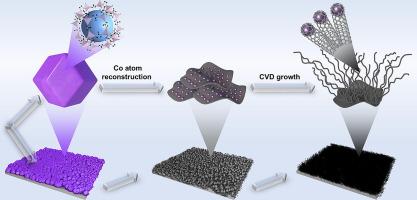ZIF-67中钴原子的重构及高性能应变传感器中碳纳米管的原位生长
IF 13.2
1区 工程技术
Q1 ENGINEERING, CHEMICAL
引用次数: 0
摘要
碳纳米管(CNTs)具有独特的物理和化学性质,在各个领域都有巨大的应用潜力,但往往受制于苛刻而复杂的合成条件。利用唑基咪唑酸框架(ZIF,如 ZIF-67)中金属(如钴)原子原子级均匀分布的优势,我们在此开发了一种以 ZIF-67 为催化剂前驱体的简便方法,在远低于传统条件(> 700 ℃)的 500 ℃ 低温下通过化学气相沉积(CVD)生长 CNT。在升温过程中,ZIF-67 中的钴原子会发生原位重构,形成适当直径的钴纳米粒子,ZIF-67 也会发生热解,同时在钴纳米粒子上形成石墨层,促进 CNT 的后续 CVD 生长。催化剂前驱体 ZIF-67 可通过溶液工艺轻松负载在任何基底上,而无需使用传统的复杂高能耗技术,这使得在各种低成本基底上大规模合成 CNTs 成为可能,并得到广泛应用。最后,演示了基于低温生长的 CNTs 应变传感器,即使在 0.4 % 的超低应变下也具有出色的灵敏度和长期稳定性。本文章由计算机程序翻译,如有差异,请以英文原文为准。

Reconstruction of cobalt atoms in ZIF-67 and in-situ growth of carbon nanotubes at low temperature for High-Performance strain sensors
Carbon nanotubes (CNTs) with unique physical and chemical properties, show greatly potential applications in various fields, but often suffer from harsh and complex synthetic conditions. Taking advantage of the atom-level uniform distribution of metal (e.g., cobalt) atom in zeolitic imidazolate framework (ZIF, e.g., ZIF-67), we here develop a facile approach using ZIF-67 as the precursor of catalyst to grow CNTs by chemical vapor deposition (CVD) at a low temperature of 500 °C, much lower than traditional condition (> 700 °C). During temperature increasing process, Co atoms in ZIF-67 are in-situ reconstructed to form Co nanoparticles with proper diameters, and pyrolysis of ZIF-67 also occurs to form a graphite layer on Co nanoparticles at the same time, promoting following CVD growth of CNTs. The catalyst precursor ZIF-67 can be easily loaded in/on any substrate through solution process instead of using traditional complex high-energy consumption techniques, which makes it possible to synthesize CNTs on various low-cost substrates in large scale for wide applications. Finally, the low-temperature grown CNTs-based strain sensor with excellent sensitivity and long-term stability even under ultralow strain of 0.4 % is demonstrated.
求助全文
通过发布文献求助,成功后即可免费获取论文全文。
去求助
来源期刊

Chemical Engineering Journal
工程技术-工程:化工
CiteScore
21.70
自引率
9.30%
发文量
6781
审稿时长
2.4 months
期刊介绍:
The Chemical Engineering Journal is an international research journal that invites contributions of original and novel fundamental research. It aims to provide an international platform for presenting original fundamental research, interpretative reviews, and discussions on new developments in chemical engineering. The journal welcomes papers that describe novel theory and its practical application, as well as those that demonstrate the transfer of techniques from other disciplines. It also welcomes reports on carefully conducted experimental work that is soundly interpreted. The main focus of the journal is on original and rigorous research results that have broad significance. The Catalysis section within the Chemical Engineering Journal focuses specifically on Experimental and Theoretical studies in the fields of heterogeneous catalysis, molecular catalysis, and biocatalysis. These studies have industrial impact on various sectors such as chemicals, energy, materials, foods, healthcare, and environmental protection.
 求助内容:
求助内容: 应助结果提醒方式:
应助结果提醒方式:


